Representative High-Temperature Hydrothermal Activities in the Himalaya Geothermal Belt (HGB): A Review and Future Perspectives
Abstract
:1. Introduction
2. Geological and Geothermal Background of the HGB
2.1. Regional Geological Structure Settings
2.2. Hydrothermal Characteristics of the HGB
3. Material and Methods
3.1. Data Collection
3.2. Geochemical Calculations
4. Genesis of Representative High-Temperature Hydrothermal Activities in the HGB
4.1. Hydrogeochemical Evolution Process of Yangbajing Geothermal Field
4.1.1. Hydrochemical Type
4.1.2. Recharge Source of Geothermal Water
4.1.3. Effects of Deep Geothermal Fluid
4.1.4. Analysis of Water–Rock Equilibrium State
4.1.5. Reservoir Temperature
4.2. Hydrogeochemical Evolution Process of Gudui Geothermal Field
4.2.1. Hydrochemical Type
4.2.2. Recharge Source of Geothermal Water
4.2.3. Effects of Deep Geothermal Fluid
4.2.4. Analysis of Water–Rock Equilibrium State
4.2.5. Reservoir Temperature
4.3. Hydrogeochemical Evolution Process of Rehai Geothermal Field
4.3.1. Hydrochemistry Type
4.3.2. Recharge Source of Geothermal Water
4.3.3. Effects of Deep Geothermal Fluid
4.3.4. Analysis of Water–Rock Equilibrium State
4.3.5. Reservoir Temperature
4.4. Comparative Analysis of Yangbajing, Gudui, and Rehai Geothermal Fields
5. Development and Utilization of Geothermal Resources
6. Conclusions
- The geothermal springs in the Yangbajing, Gudui, and Rehai geothermal fields are primarily sourced from deep Cl-Na geothermal fluids. The geological environments of the Yangbajing and Gudui geothermal fields are relatively closed, resulting in a low proportion of cold water mixing. The hydrochemical type of the exposed geothermal springs is predominantly Cl-Na. The Rehai geothermal field has an open geological environment with a high proportion of shallow cold water. This causes the hydrochemical type of the geothermal spring to change from a Cl-Na type to an HCO3·Cl-Na type due to water–rock interaction and mixing with shallow cold water.
- The geothermal waters in Yangbajing and Gudui are primarily recharged by snow-meltwater and magmatic water, with magmatic water accounting for 17% and 21%, respectively. The geothermal waters are mainly recharged by local meteoric water and subduction-related volcanic water (with an average mixing ratio of 22%). The recharge elevations of the three geothermal fields are 5174–5736 m, 4764–5186 m, and 1182–2350 m, respectively.
- The Rehai geothermal field boasts the highest thermal reservoir temperature at 282 °C, followed by the Gudui geothermal field at 266 °C, and finally the Yangbajing geothermal field at 237 °C. Due to significant heat loss during the rising process in the Rehai geothermal field, the average temperature of the exposed geothermal springs in this area is lower than that of the Yangbajing and Gudui areas.
Supplementary Materials
Author Contributions
Funding
Data Availability Statement
Conflicts of Interest
References
- Lund, J.W.; Toth, A.N. Direct utilization of geothermal energy 2020 worldwide review. Geothermics 2021, 90, 101915. [Google Scholar] [CrossRef]
- Wang, Y.; Yuan, X.; Zhang, Y.; Zhang, X.; Xiao, Y.; Duo, J.; Huang, X.; Sun, M.; Lv, G. Hydrochemical, D–O–Sr isotopic and electromagnetic characteristics of geothermal waters from the Erdaoqiao area, SW China: Insights into genetic mechanism and scaling potential. Ore Geol. Rev. 2023, 158, 105486. [Google Scholar] [CrossRef]
- Zhou, H.; Kuang, X.; Hao, Y.; Wang, C.; Feng, Y.; Zou, Y.; Zhu, M.; Zheng, C. Magmatic fluid input controlling the geochemical and isotopic characteristics of geothermal waters along the Yadong-Gulu rift, southern Tibetan Plateau. J. Hydrol. 2023, 619, 129196. [Google Scholar] [CrossRef]
- National Energy Administration. 13th Five-Year Plan for Modern Energy System. Available online: https://www.nea.gov.cn/135989417_14846217874961n.pdf (accessed on 14 March 2024). (In Chinese)
- Wang, G.L.; Zhang, W.; Liang, J.Y.; Lin, W.; Liu, Z.M.; Wang, W. Evaluation of Geothermal Resources Potential in China. Acta Geosci. Sin. 2017, 38, 449–459. [Google Scholar] [CrossRef]
- He, P.; Zhang, H.; Li, S.; Zhou, X.; Zhou, X.; He, M.; Tian, J.; Zhang, Y.; Wu, Z.; Chen, T.; et al. Geological and hydrochemical controls on water chemistry and stable isotopes of hot springs in the Three Parallel Rivers Region, southeast Tibetan Plateau: The genesis of geothermal waters. Sci. Total Environ. 2023, 906, 167648. [Google Scholar] [CrossRef]
- Muffler, P.; Cataldi, R. Methods for regional assessment of geothermal resources. Geothermics 1978, 7, 53–89. [Google Scholar] [CrossRef]
- Guo, Q.; Pang, Z.; Wang, Y.; Tian, J. Fluid geochemistry and geothermometry applications of the Kangding high-temperature geothermal system in eastern Himalayas. Appl. Geochem. 2017, 81, 63–75. [Google Scholar] [CrossRef]
- Arellano, V.M.; Garcia-Gutierrez, A.; Barrgan, R.M.; Izquierdo, G.; Nieva, D. An updated conceptual model of the Los Humeros geothermal reservoir (Mexico). J. Volcanol. Geotherm. Res. 2003, 124, 67–88. [Google Scholar] [CrossRef]
- Sanada, T.; Takamatsu, N.; Yoshiike, Y. Geochemical interpretation of long-term variations in rare earth element concentrations in acidic hot spring waters from the Tamagawa geothermal area, Japan. Geothermics 2006, 35, 141–155. [Google Scholar] [CrossRef]
- Taussi, M.; Nisi, B.; Brogi, A.; Liotta, D.; Zucchi, M.; Venturi, S.; Cabassi, J.; Boschi, G.; Ciliberti, M.; Vaselli, O. Deep Regional Fluid Pathways in an Extensional Setting: The Role of Transfer Zones in the Hot and Cold Degassing Areas of the Larderello Geothermal System (Northern Apennines, Italy). Geochem. Geophys. Geosyst. 2023, 24, e2022GC010838. [Google Scholar] [CrossRef]
- Taussi, M.; Brogi, A.; Liotta, D.; Nisi, B.; Perrini, M.; Vaselli, O.; Zambrano, M.; Zucchi, M. CO2 and heat energy transport by enhanced fracture permeability in the Monterotondo Marittimo-Sasso Pisano transfer fault system (Larderello Geothermal Field, Italy). Geothermics 2022, 105, 102531. [Google Scholar] [CrossRef]
- Tian, J.; Pang, Z.; Guo, Q.; Wang, Y.; Li, J.; Huang, T.; Kong, Y. Geochemistry of geothermal fluids with implications on the sources of water and heat recharge to the Rekeng high-temperature geothermal system in the Eastern Himalayan Syntax. Geothermics 2018, 74, 92–105. [Google Scholar] [CrossRef]
- Christenson, B.W.; Mroczek, E.K.; Kennedy, B.M.; Soest, M.C.V.; Stewart, M.K.; Lyon, G. Ohaaki reservoir chemistry: Characteristics of an arc-type hydrothermal system in the Taupo Volcanic Zone, New Zealand. J. Volcanol. Geotherm. Res. 2002, 115, 53–82. [Google Scholar] [CrossRef]
- Karaku, H. Helium and carbon isotope composition of gas discharges in the Simav Geothermal Field, Turkey: Implications for the heat source. Geothermics 2015, 57, 213–223. [Google Scholar] [CrossRef]
- Gola, G.; Bertini, G.; Bonini, M.; Botteghi, S.; Brogi, A.; De Franco, R.; Dini, A.; Donato, A.; Gianelli, G.; Liotta, D.; et al. Data integration and conceptual modelling of the Larderello geothermal area, Italy. Energy Procedia 2017, 125, 300–309. [Google Scholar] [CrossRef]
- Guo, Q. Hydrogeochemistry of high-temperature geothermal systems in China: A review. Appl. Geochem. 2012, 27, 1887–1898. [Google Scholar] [CrossRef]
- Wu, Y.; Zhou, X. Structural control effects on hot springs’ hydrochemistry in the northern Red River Fault Zone: Implications for geothermal systems in fault zones. J. Hydrol. 2023, 623, 129836. [Google Scholar] [CrossRef]
- Yang, H.; Yuan, X.; Chen, Y.; Liu, J.; Zhan, C.; Lv, G.; Hu, J.; Sun, M.; Zhang, Y. Geochemical Evidence Constraining Genesis and Mineral Scaling of the Yangbajing Geothermal Field, Southwestern China. Water 2023, 16, 24. [Google Scholar] [CrossRef]
- Naik, P.K.; Awasthi, A.K.; Mohan, P.C. Springs in a headwater basin in the Deccan Trap country of the Western Ghats, India. Hydrogeol. J. 2002, 10, 553–565. [Google Scholar] [CrossRef]
- Lv, G.; Zhang, X.; Wei, D.; Yu, Z.; Yuan, X.; Sun, M.; Kong, X.; Zhang, Y. Water–Rock Interactions, Genesis Mechanism, and Mineral Scaling of Geothermal Waters in Northwestern Sichuan, SW China. Water 2023, 15, 3730. [Google Scholar] [CrossRef]
- Tian, J.; Stefánsson, A.; Li, Y.; Li, L.; Xing, L.; Li, Z.; Li, Y.; Zhou, X. Geochemistry of thermal fluids and the genesis of granite-hosted Huangshadong geothermal system, Southeast China. Geothermics 2023, 109, 102647. [Google Scholar] [CrossRef]
- Zhang, Y.; Xu, M.; Li, X.; Qi, J.; Zhang, Q.; Guo, J.; Yu, L.; Zhao, R. Hydrochemical Characteristics and Multivariate Statistical Analysis of Natural Water System: A Case Study in Kangding County, Southwestern China. Water 2018, 10, 80. [Google Scholar] [CrossRef]
- Guo, Q.; Planer-Friedrich, B.; Liu, M.; Yan, K.; Wu, G. Magmatic fluid input explaining the geochemical anomaly of very high arsenic in some southern Tibetan geothermal waters. Chem. Geol. 2019, 513, 32–43. [Google Scholar] [CrossRef]
- Li, X.; Qi, J.; Yi, L.; Xu, M.; Zhang, X.; Zhang, Q.; Tang, Y. Hydrochemical characteristics and evolution of geothermal waters in the eastern Himalayan syntaxis geothermal field, southern Tibet. Geothermics 2021, 97, 102233. [Google Scholar] [CrossRef]
- Singh, H.K.; Chandrasekharam, D.; Raju, N.J.; Ranjan, S. Geothermal energy potential in relation to black carbon reduction and CO2 mitigation of Himalayan geothermal belt—A review. Geothermics 2024, 119, 102962. [Google Scholar] [CrossRef]
- Zhang, C.; Shi, Q.; Lingjuan, Z. Discussion on the relationship between Cenozoic magmatic activity and geotherm in Tibetan Plateau. Geol. Surv. China 2018, 5, 18–24. [Google Scholar] [CrossRef]
- Liao, Z.; Zhao, P. Yunnan-Tibet Geothermal Belt-Geothermal Resources and Case Histories; Science Press: Beijing, China, 1999. [Google Scholar]
- Duo, J. The basic characteristics of the Yangbajing geothermal field—A typical high temperature geothermal system. Eng. Sci. 2003, 5, 42–47. [Google Scholar]
- Wang, S. Hydrogeochemical Processes and Genesis Machenism of High-temperature Geothermal System in Gudui, Tibet. Ph.D. Thesis, China University of Geosciences, Beijing, China, 2017. (In Chinese). [Google Scholar]
- Ma, R.; Shi, J.; Liu, J.; Gui, C. Combined use of multivariate statistical analysis and hydrochemical analysis for groundwater quality evolution: A case study in north chain plain. J. Earth Sci. 2014, 25, 587–597. [Google Scholar] [CrossRef]
- Zhang, Y. Study on the Genesis and Development and Utilization of Geothermal System in Kangding-Moxi Section of Xianshuihe Fault; Chengdu University of Technology: Chengdu, China, 2018. [Google Scholar]
- Hou, Z.; Mo, X.; Gao, Y.; Yang, Z.; Dong, G.; Ding, L. Early Processes and Tectonic Model for the Indian-Asian Continental Collision: Evidence from the Cenozoic Gangdese Igneous Rocks in Tibet. Acta Geol. Sin. 2006, 80, 1233–1248. [Google Scholar]
- Wang, C.; Zheng, M.; Zhang, X.; Xing, E.; Zhang, J.; Ren, J.; Ling, Y. O, H, and Sr isotope evidence for origin and mixing processes of the Gudui geothermal system, Himalayas, China. Geosci. Front. 2020, 11, 1175–1187. [Google Scholar] [CrossRef]
- Elenga, H.I.; Tan, H.; Su, J.; Yang, J. Origin of the enrichment of B and alkali metal elements in the geothermal water in the Tibetan Plateau: Evidence from B and Sr isotopes. Geochemistry 2021, 81, 125797. [Google Scholar] [CrossRef]
- Wang, S. Distribution of Conjugate Angles of Seismic Faults in the Qinghai-Tibet Plateau and Its Implications for Continental Dynamics. Acta Geol. Sin. 2004, 78, 475–481. [Google Scholar]
- Wang, P.; Chen, X.; Shen, L.; Xiao, Q.; Wu, X. Reservoir temperature of geothermal anomaly area and its environmental effect in Tibet. Geol. China 2016, 43, 1429–1438. [Google Scholar] [CrossRef]
- Wang, Y.; Li, L.; Wen, H.; Hao, Y. Geochemical evidence for the nonexistence of supercritical geothermal fluids at the Yangbajing geothermal field, southern Tibet. J. Hydrol. 2022, 604, 127243. [Google Scholar] [CrossRef]
- Meng, H.R.; Cao, R.; Chen, D.F.; Ngawang, G.; Luo, W.X.; Cai, Y.Q.; Yan, Y.M. Types, Distribution Characteristics, and Exploration Direction of Hydrothermal Alteration in Gudui Geothermal Field, Tibet. Acta Geosci. Sin. 2023, 44, 158–168. [Google Scholar] [CrossRef]
- Yuan, J.; Cao, H.; Guo, Y.; Chen, X. Source and Evolution of Subduction–Related Hot Springs Discharged in Tengchong Geothermal Field, Southwest China: Constrained by Stable H, O, and Mg Isotopes. Minerals 2022, 12, 1490. [Google Scholar] [CrossRef]
- Zhang, M.; Guo, Z.; Sano, Y.; Zhang, L.; Sun, Y.; Cheng, Z.; Yang, T.F. Magma-derived CO2 emissions in the Tengchong volcanic field, SE Tibet: Implications for deep carbon cycle at intra-continent subduction zone. J. Asian Earth Sci. 2016, 127, 76–90. [Google Scholar] [CrossRef]
- Guo, Q.; Wang, Y.; Liu, W. Major hydrogeochemical processes in the two reservoirs of the Yangbajing geothermal field, Tibet, China. J. Volcanol. Geotherm. Res. 2007, 166, 255–268. [Google Scholar] [CrossRef]
- Wang, C.; Zheng, M. Hydrochemical Characteristics and Evolution of Hot Fluids in the Gudui Geothermal Field in Comei County, Himalayas. Geothermics 2019, 81, 243–258. [Google Scholar] [CrossRef]
- Liu, M. Source of Hydrochemical Composition and Formation Mechanism of Rehai Geothermal Water in Tengchong. Safety and Environmental Engineering. 2014, 21, 1–7. (In Chinese) [Google Scholar] [CrossRef]
- Shangguan, Z.; Sun, M.; Li, H. Active types of modern geothermal fluids at the Tengchong region, Yunnan province. Seismol. Geol. 1999, 21, 437–442. [Google Scholar]
- Guo, Q.; Wang, Y. Geochemistry of hot springs in the Tengchong hydrothermal areas, Southwestern China. J. Volcanol. Geotherm. Res. 2012, 215–216, 61–73. [Google Scholar] [CrossRef]
- Li, J.; Sagoe, G.; Yang, G.; Liu, D.; Li, Y. The application of geochemistry to bicarbonate thermal springs with high reservoir temperature: A case study of the Batang geothermal field, western Sichuan Province, China. J. Volcanol. Geotherm. Res. 2019, 371, 20–31. [Google Scholar] [CrossRef]
- Brown, L.D.; Zhao, W.; Nelson, K.D.; Hauck, M.; Alsdorf, D.; Ross, A.; Cogan, M.; Clark, M.; Liu, X.; Che, J. Bright Spots, Structure, and Magmatism in Southern Tibet from INDEPTH Seismic Reflection Profiling. Science 1996, 274, 1688–1690. [Google Scholar] [CrossRef] [PubMed]
- Nelson, K.D.; Zhao, W.; Brown, L.D.; Kuo, J.; Che, J.; Liu, X.; Klemperer, S.L.; Makovsky, Y.; Meissner, R.; Mechie, J.; et al. Partially Molten Middle Crust Beneath Southern Tibet: Synthesis of Project INDEPTH Results. Science 1996, 274, 1684–1688. [Google Scholar] [CrossRef] [PubMed]
- Chen, L.; Booker, J.R.; Jones, A.G.; Wu, N.; Unsworth, M.J.; Wei, W.; Tan, H. Electrically Conductive Crust in Southern Tibet from INDEPTH Magnetotelluric Surveying. Science 1996, 274, 1694–1696. [Google Scholar] [CrossRef] [PubMed]
- Kind, R.; Ni, J.; Zhao, W.; Wu, J.; Yuan, X.; Zhao, L.; Sandvol, E.; Reese, C.; Nabelek, J.; Hearn, T. Evidence from Earthquake Data for a Partially Molten Crustal Layer in Southern Tibet. Science 1996, 274, 1692–1694. [Google Scholar] [CrossRef] [PubMed]
- Tan, H.; Wei, W.; Martyn, U.; Deng, M.; Jin, S. Crustal electrical conductivity structure beneath the Yarlung Zangbo Jiang suture in the southern Xizang plateau. Chin. J. Geophys. 2004, 47, 685–690. [Google Scholar]
- Bai, D.; Liao, Z.; Zhao, G.; Wang, X. The Inference of Magmatic Heat Source Beneath the Rehai (Hot Sea) Field of Tengchong From the Result of Magnetotelluric Sounding. Chin. Sci. Bull. 1994, 39, 572–577. [Google Scholar]
- Fang, N. Study on Geological Characteristics and Formation Mechanism of Tengchong Rehai Geothermal Field. Master’s Thesis, Kunming University of Science and Technology, Kunming, China, 2013. (In Chinese). [Google Scholar]
- Guo, T. Study on the Characteristics and Genesis of Rehai Geothermal Field in Tengchong, Yunnan. Ph.D. Thesis, Kunming University of Science and Technology, Kunming, China, 2013. (In Chinese). [Google Scholar]
- Sun, M. Hydrochemical Characteristics and Genetic Mechanism of Geothermal Resource in the Yangbajing Area, Tibet; Tibet University: Lhasa, China, 2023. (In Chinese) [Google Scholar]
- Duoji. Typical high temperature geothermal system-basic characteristics of Yangbajing geothermal field. Strateg. Study CAE 2003, 5, 42–47. (In Chinese) [Google Scholar]
- Zhao, C.; Ran, H.; Chen, K. Present-day magma chambers in Tengchong volcano area inferred relative geothermal gradient. Acta Petrol. Sin. 2006, 22, 1517–1528. [Google Scholar]
- Wang, G. Geothermal Resources in China; Sciences Press: Beijing, China, 2018. (In Chinese) [Google Scholar]
- Guo, Q.; Wang, Y.; Liu, W. O, H, and Sr isotope evidences of mixing processes in two geothermal fluid reservoirs at Yangbajing, Tibet, China. Environ. Earth Sci. 2010, 59, 1589–1597. [Google Scholar] [CrossRef]
- Pang, Z. pH dependant isotope variations in arc-type geothermal waters: New insights into their origins. J. Geochem. Explor. 2006, 89, 306–308. [Google Scholar] [CrossRef]
- Sun, H.; Ma, F.; Lin, W.; Liu, Z.; Wang, G.; Nan, D. Geochemical Characteristics and Geothermometer Application in High Temperature Geothermal Field in Tibet. Geol. Sci. Technol. Inf. 2015, 34, 171. (In Chinese) [Google Scholar]
- Zhao, P.; Jin, J.; Zhang, H.; Ji, D.; Liang, T. Chemical composition of thermal water in the Yangbajing geothermal field, Tibet. Chin. J. Geol. 1998, 33, 61–72. [Google Scholar]
- Piper, A. A Graphic Procedure in the Geochemical Interpretation of Water-Analyses. Eos Trans. Am. Geophys. Union 1944, 25, 914–923. [Google Scholar]
- Craig, H. Isotopic variations in meteoric waters. Science 1961, 133, 1702–1703. [Google Scholar] [CrossRef] [PubMed]
- Yu, J.; Zhang, H.; Yu, F.; Liu, D. Oxygen and hydrogen isotopic compositions of meteoric waters in the eastern part of Xizang. Chin. J. Geochem. 1984, 13, 93–101. [Google Scholar] [CrossRef]
- Arnórsson, S.; Andrésdóttir, A. Processes controlling the distribution of boron and chlorine in natural waters in Iceland. Geochim. Et Cosmochim. Acta 1995, 59, 4125–4146. [Google Scholar] [CrossRef]
- Truesdell, A.H.; Nathenson, M.; Rye, R.O. The effects of subsurface boiling and dilution on the isotopic compositions of Yellowstone thermal waters. J. Geophys. Res. 1977, 82, 3694–3704. [Google Scholar] [CrossRef]
- Tassi, F.; Aguilera, F.; Darrah, T.; Vaselli, O.; Capaccioni, B.; Poreda, R.J.; Delgado Huertas, A. Fluid geochemistry of hydrothermal systems in the Arica-Parinacota, Tarapacá and Antofagasta regions (northern Chile). J. Volcanol. Geotherm. Res. 2010, 192, 1–15. [Google Scholar] [CrossRef]
- Giggenbach, W.F. Geothermal solute equilibria. derivation of Na-K-Mg-Ca geoindicators. Geochim. Et Cosmochim. Acta 1988, 52, 2749–2765. [Google Scholar] [CrossRef]
- Henley, R.W.; Ellis, A.J. Geothermal systems ancient and modern: A geochemical review. Earth-Sci. Rev. 1983, 19, 1–50. [Google Scholar] [CrossRef]
- Tan, H.; Zhang, Y.; Zhang, W.; Kong, N.; Zhang, Q.; Huang, J. Understanding the circulation of geothermal waters in the Tibetan Plateau using oxygen and hydrogen stable isotopes. Appl. Geochem. 2014, 51, 23–32. [Google Scholar] [CrossRef]
- Zhang, W.; Wang, G.; Zhao, J.; Liu, F. Geochemical Characteristics of Medium-high Temperature Geothermal Fluids in West Sichuan and Their Geological Implications. Geoscience 2021, 35, 188–198. [Google Scholar] [CrossRef]
- Ma, Z. A comparative study of isotopic hydrogeochemistry of geothermal fluids of sedimentary basin type and volcanic type. Hydrogeol. Eng. Geol. 2019, 46, 9–18. [Google Scholar] [CrossRef]
- Fan, Y.; Chen, Y.; Li, X.; Li, W.; Li, Q. Characteristics of water isotopes and ice-snowmelt quantification in the Tizinafu River, north Kunlun Mountains, Central Asia. Quat. Int. 2015, 380–381, 116–122. [Google Scholar] [CrossRef]
- Long, M. Characteristics and Formation of Some of the Hot Springs in Tengchong County of Yunnan. Master’s Thesis, China University of Geosciences, Beijing, China, 2015. (In Chinese). [Google Scholar]
- Li, J.; Guo, Q.; Wang, Y. Evaluation of temperature of parent geothermal fluid and its cooling processes during ascent to surface: A case study in Rehai geothermal field, Tengchong. Earth Sci. 2015, 40, 1576–1584. [Google Scholar] [CrossRef]
- Li, Z. Modern Geothermal Water Activities during the Collisional Orogeny of the Qinghai-Tibet Plateau. Ph.D. Thesis, Chinese Academy of Geological Sciences, Beijing, China, 2002. (In Chinese). [Google Scholar]
- Zhao, X.; Fu, H. Analysis of current status and prospects of geothermal energy development and utilization. Environ. Dev. 2019, 31, 233–235. [Google Scholar]
- Li, Y.; Pang, Z.; Galeczka, I.M. Quantitative assessment of calcite scaling of a high temperature geothermal well in the Kangding geothermal field of Eastern Himalayan Syntax. Geothermics 2020, 87, 101844. [Google Scholar] [CrossRef]
- Zhao, B.; Lyu, Y.; Wen, R.; Gong, Y.; Wang, S. Utilization situation and development prospect of geothermal energy in Tibet. Therm. Power Gener. 2023, 52, 1–6. [Google Scholar]
- Wang, L.; Li, H.; Bu, X. Multi-objective optimization of Binary Flashing Cycle (BFC) driven by geothermal energy. Appl. Therm. Eng. 2020, 166, 114693. [Google Scholar] [CrossRef]
- Fournier, R.O.; Potter, R.W., II. A Revised and expanded silica (quartz) geothermometer. Bull. Geoth. Resour. Counc. 1982, 11, 3–12. [Google Scholar]
- Can, İ. A new improved Na/K geothermometer by artificial neural networks. Geothermics 2002, 31, 751–760. [Google Scholar] [CrossRef]
- Fournier, R.O.; Truesdell, A.H. An empirical NaKCa geothermometer for natural waters. Geochim. Cosmochim. Acta 1973, 37, 1255–1275. [Google Scholar] [CrossRef]
- Zhang, W.; Tan, H.; Zhang, Y.; Wei, H.; Dong, T. Boron geochemistry from some typical Tibetan hydrothermal systems: Origin and isotopic fractionation. Appl. Geochem. 2015, 63, 436–445. [Google Scholar] [CrossRef]
- Yan, K.; Wan, D. Study on chemical characteristics and formation mechanism of Tengchong Rehai hot spring group. J. Seismol. Res. 1998, 21, 9. (In Chinese) [Google Scholar]
- Yuan, J. Transport of Boron in the Aquatic Environment of the Yangbajing Geothermal Field, Tibet. Master’s Thesis, China University of Geosciences (Wuhan), Wuhan, China, 2010. [Google Scholar]
- Zhou, L. Characteristics of Typical Hot SPRINGS in central Tibet. Master’s Thesis, China University of Geosciences (Beijing), Beijing, China, 2012. (In Chinese). [Google Scholar]
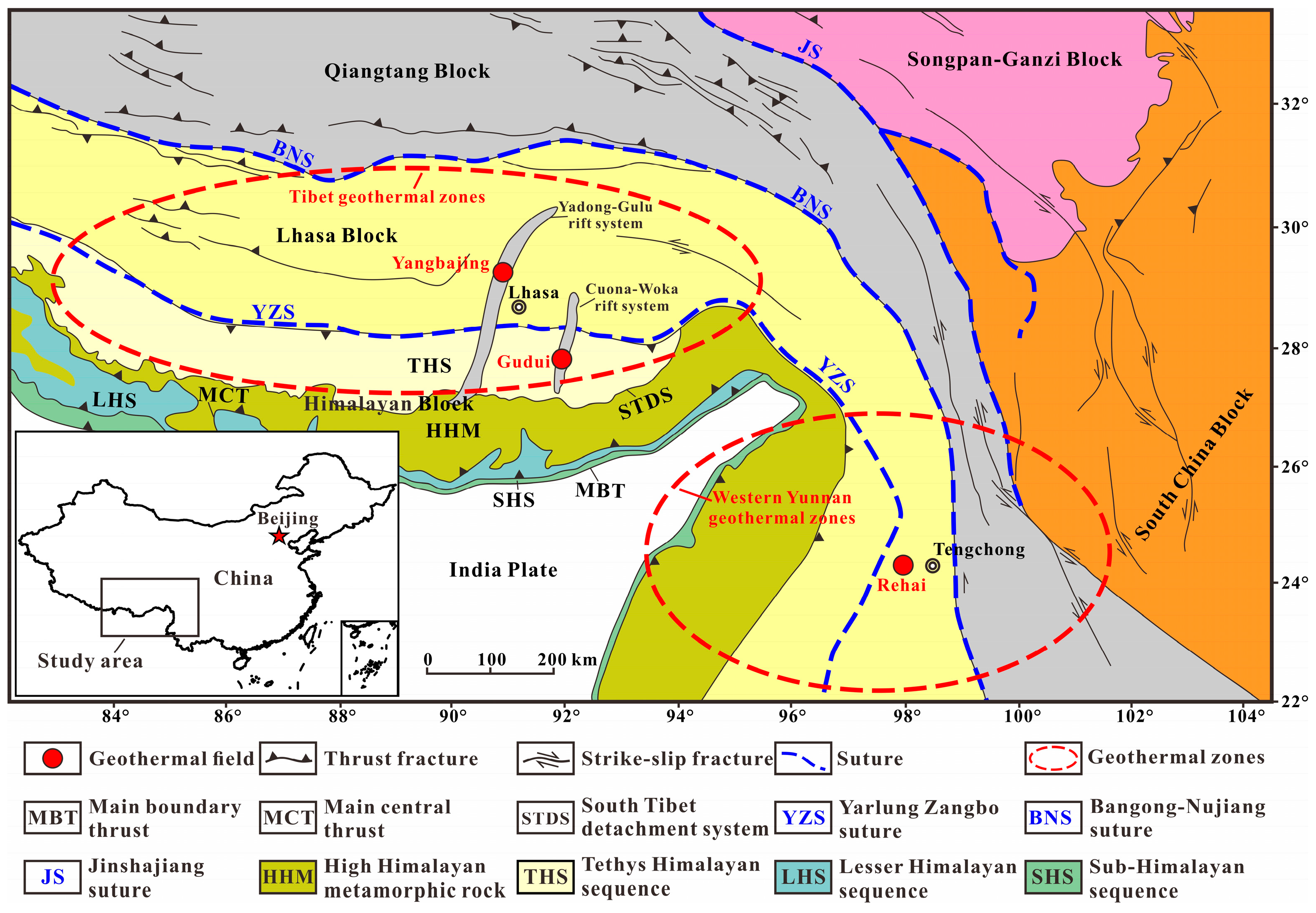





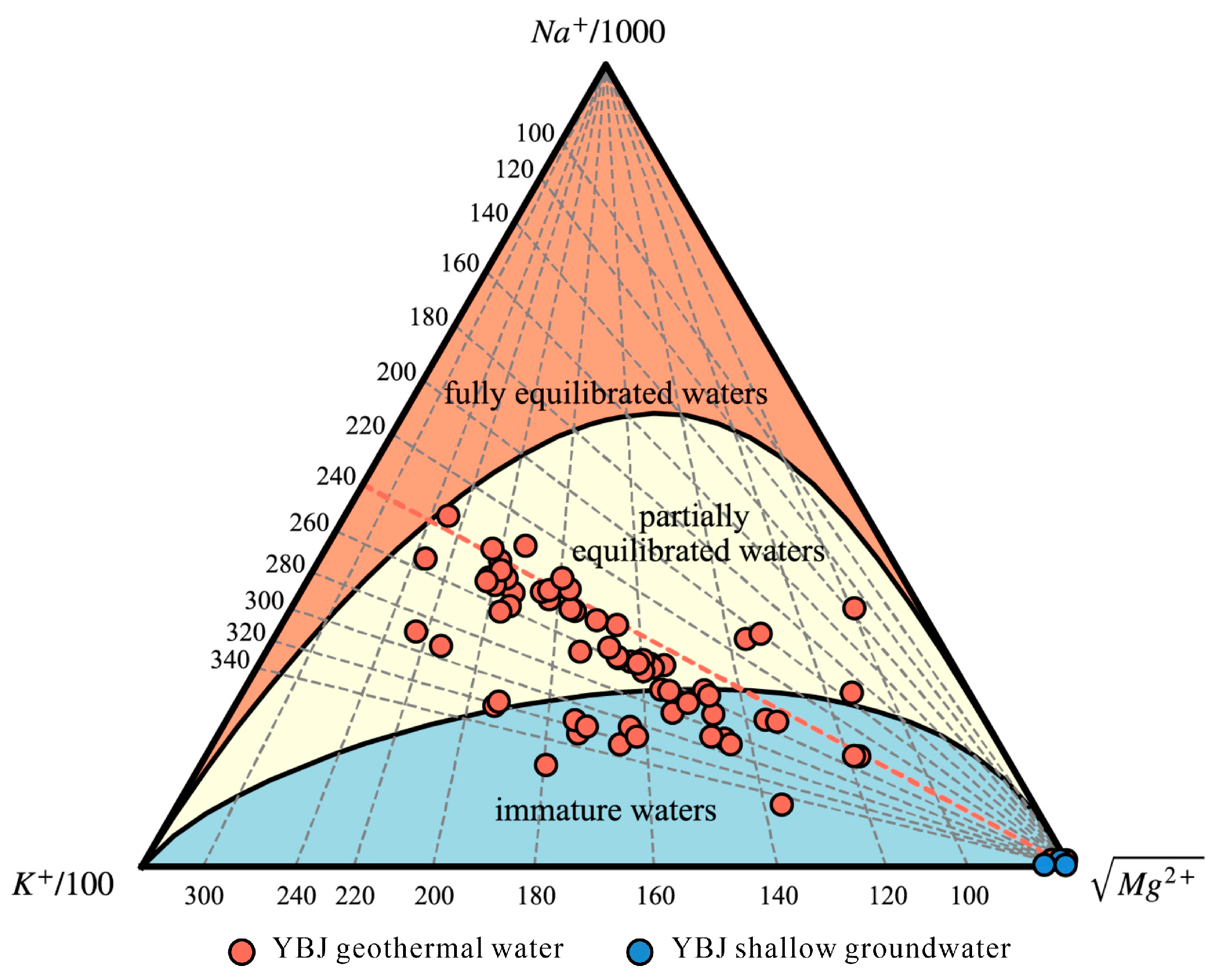




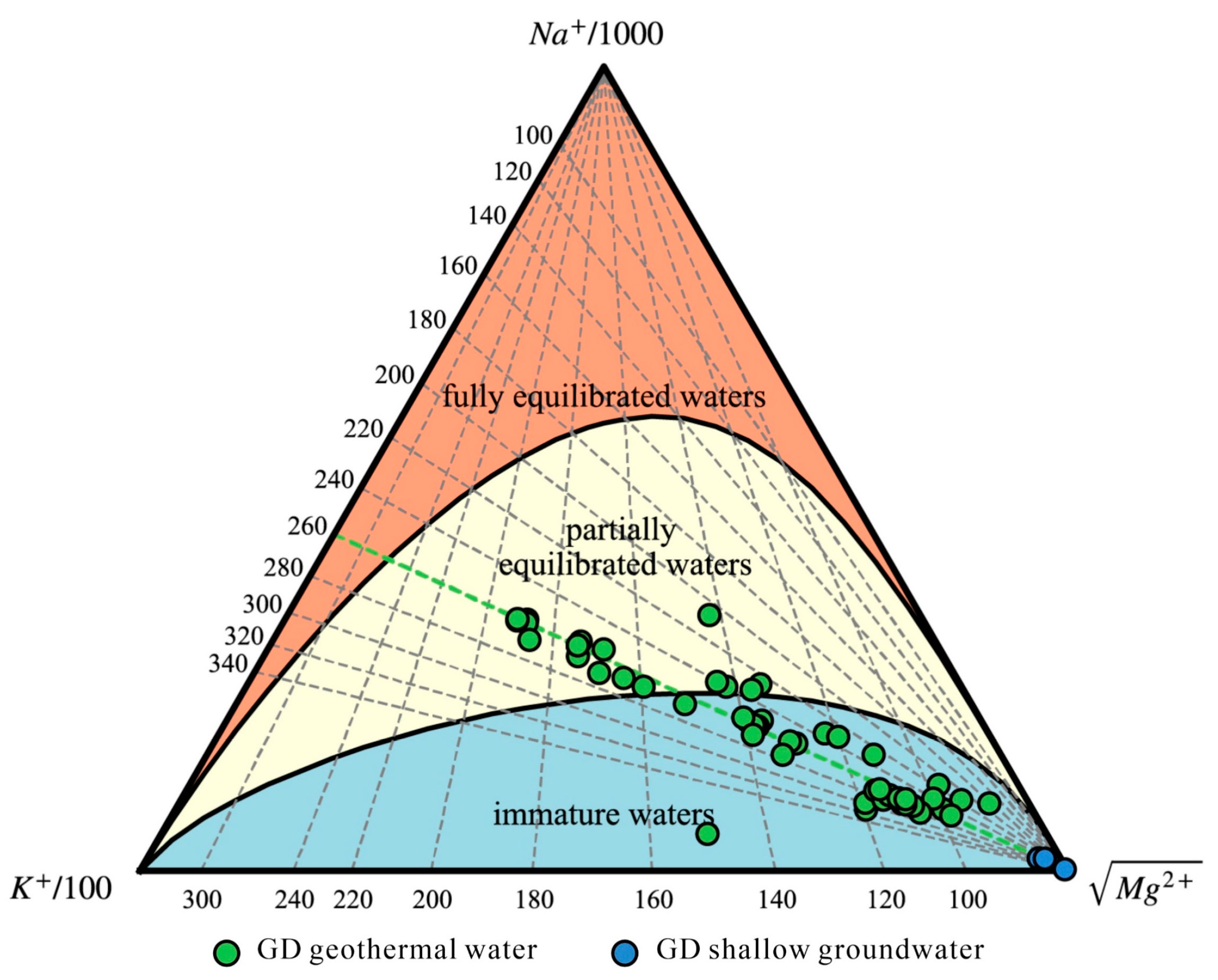
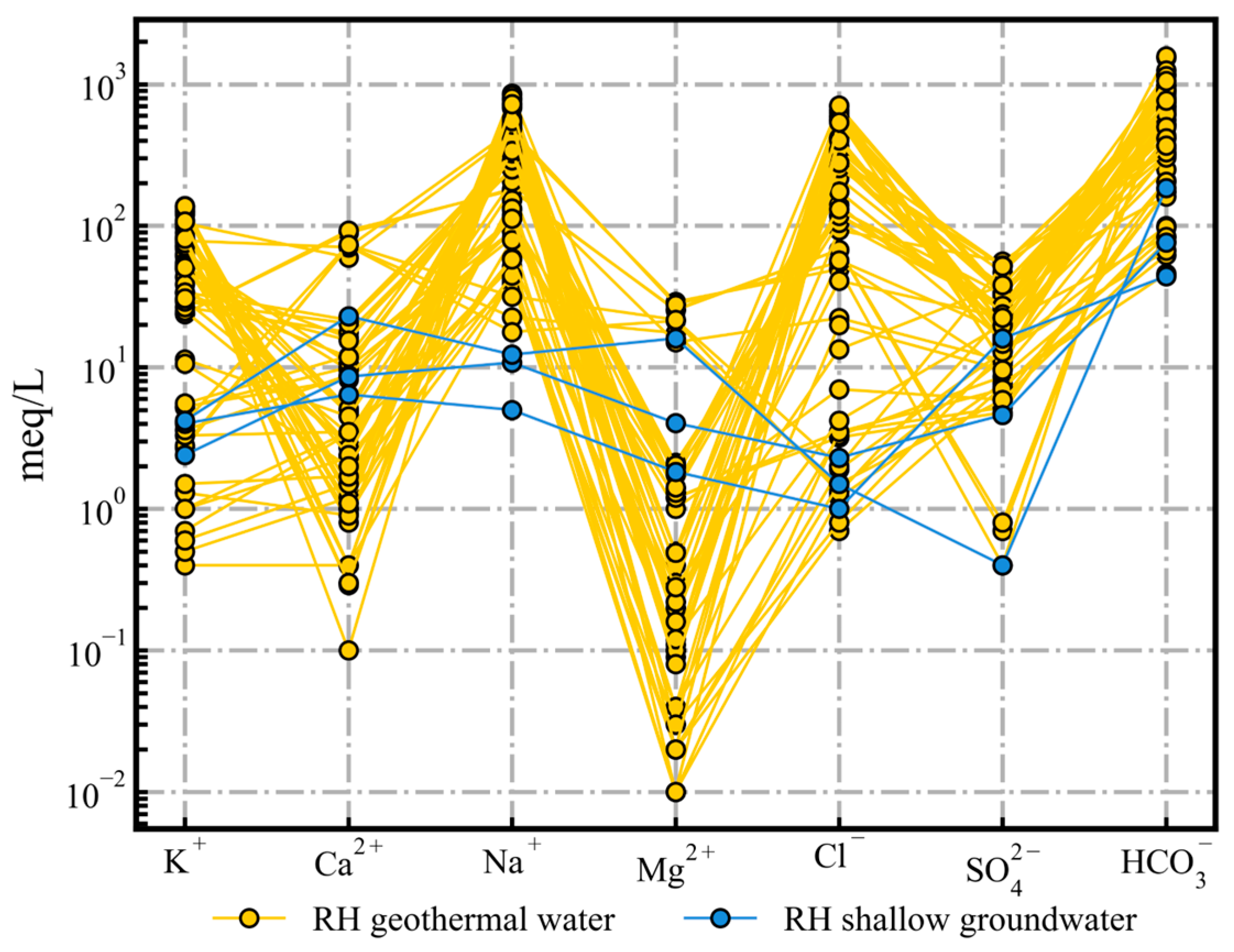
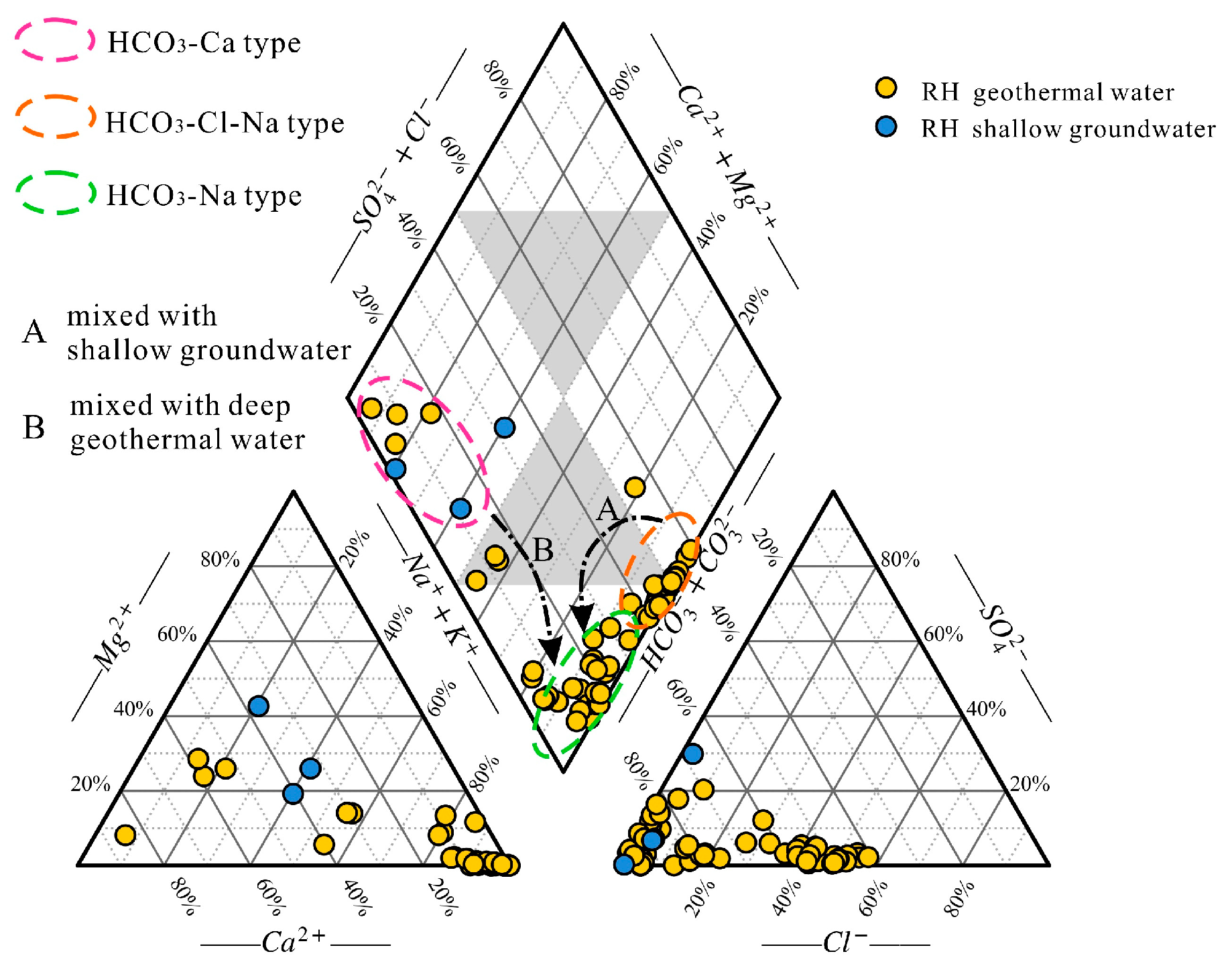



Disclaimer/Publisher’s Note: The statements, opinions and data contained in all publications are solely those of the individual author(s) and contributor(s) and not of MDPI and/or the editor(s). MDPI and/or the editor(s) disclaim responsibility for any injury to people or property resulting from any ideas, methods, instructions or products referred to in the content. |
© 2024 by the authors. Licensee MDPI, Basel, Switzerland. This article is an open access article distributed under the terms and conditions of the Creative Commons Attribution (CC BY) license (https://creativecommons.org/licenses/by/4.0/).
Share and Cite
Li, Q.; Hao, Y.; Liu, C.; Huang, J.; Yuan, X. Representative High-Temperature Hydrothermal Activities in the Himalaya Geothermal Belt (HGB): A Review and Future Perspectives. Water 2024, 16, 1378. https://doi.org/10.3390/w16101378
Li Q, Hao Y, Liu C, Huang J, Yuan X. Representative High-Temperature Hydrothermal Activities in the Himalaya Geothermal Belt (HGB): A Review and Future Perspectives. Water. 2024; 16(10):1378. https://doi.org/10.3390/w16101378
Chicago/Turabian StyleLi, Qing, Yanchun Hao, Chuanxin Liu, Jinhang Huang, and Xingcheng Yuan. 2024. "Representative High-Temperature Hydrothermal Activities in the Himalaya Geothermal Belt (HGB): A Review and Future Perspectives" Water 16, no. 10: 1378. https://doi.org/10.3390/w16101378
APA StyleLi, Q., Hao, Y., Liu, C., Huang, J., & Yuan, X. (2024). Representative High-Temperature Hydrothermal Activities in the Himalaya Geothermal Belt (HGB): A Review and Future Perspectives. Water, 16(10), 1378. https://doi.org/10.3390/w16101378





